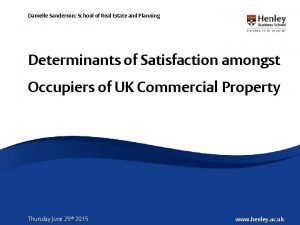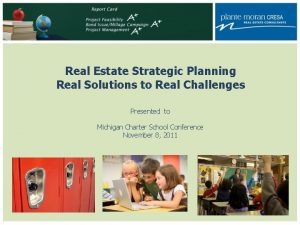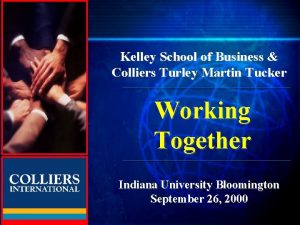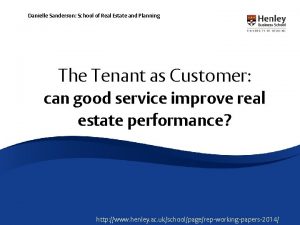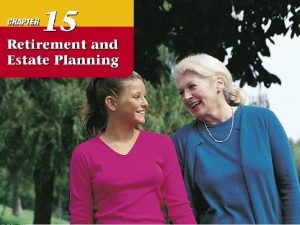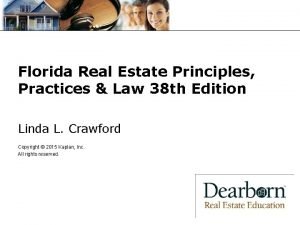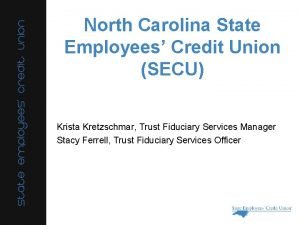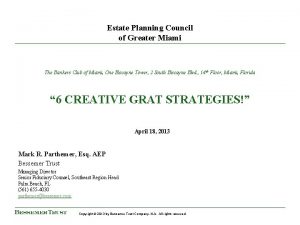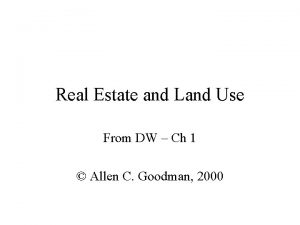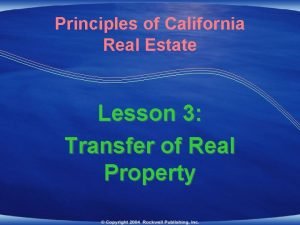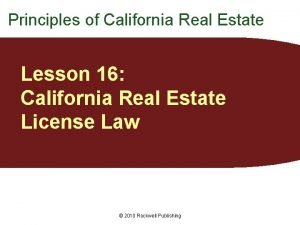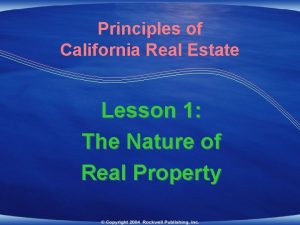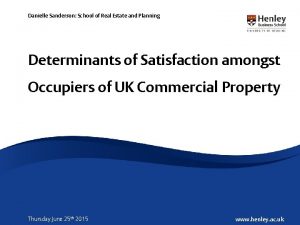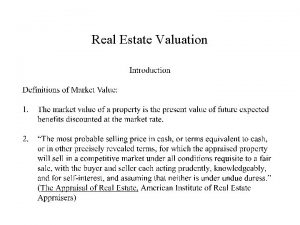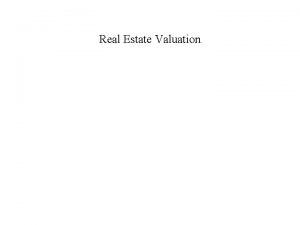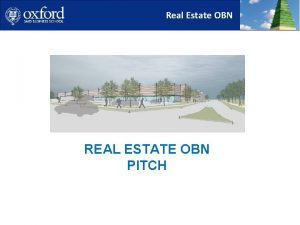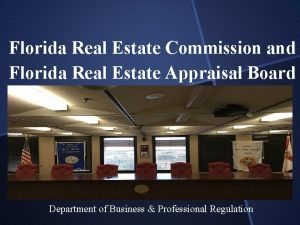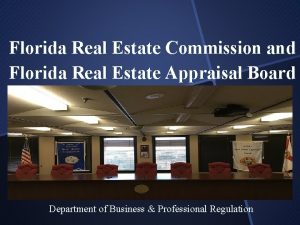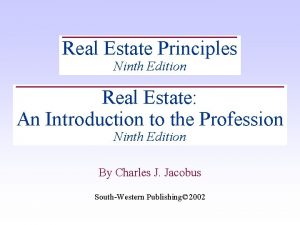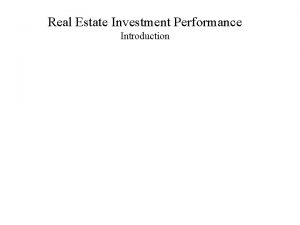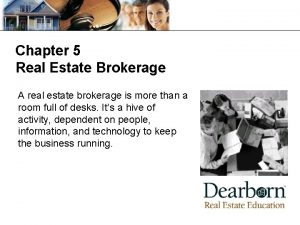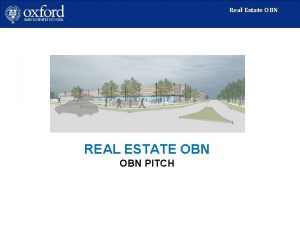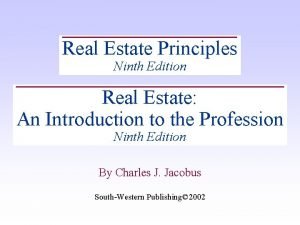Danielle Sanderson School of Real Estate and Planning





































- Slides: 37

Danielle Sanderson: School of Real Estate and Planning Determinants of Satisfaction amongst Occupiers of UK Commercial Property Thursday June 25 th 2015 www. henley. ac. uk

Determinants of Satisfaction amongst Occupiers of UK Commercial Property • Introduction: – Why does occupier satisfaction matter? – A Service-Profit Cycle for Property Management • Occupier Perceptions: Satisfaction with Service Quality – Literature Review – Data – Methodology – Results • Behavioural Intentions: Lease-Renewal and Willingness to Recommend • Key Findings 2

Why does Occupier Satisfaction Matter? • Traditionally tenants were treated as a “source of upwardly mobile income” Nowadays we must recognize that “it is the tenants that are mobile and that their custom must be earned” (Edington, 1997, p. xii) • 25 -year Commercial Leases superseded by leases of little more than 5 years, with break clauses (IPD, Strutt & Parker, 2012) • The provision of commercial property is a business, and businesses need satisfied customers in order to survive (Fornell, 2007) • “The Tenant as Customer: Does Good Service Enhance Property Performance? ” (Sanderson, 201 X!) - But what is “Good Service? ” 3

Service-Profit Cycle for Commercial Property Demand for Property Good Reputation Good Service Recommend Landlord Satisfied Occupiers Renew Lease

Occupier Satisfaction with Service Quality Literature Review • Characteristics of SERVICE include “intangibility, relative inseparability of production and consumption, and relative heterogeneity by virtue of involving the interaction of service personnel and customers, making each instance of service different” (Schneider & White, 2004, p 8) • Many researchers have attempted to assess, define and model quality in service encounters, including Kano, Grönroos and Gummesson • Most widely used approach is SERVQUAL (Parasuraman, Zeithaml, & Berry, 1985, 1988, etc!), based upon gaps between the service expected and the service experienced • Original model included ten determinants of service quality: Access, Communication, Competence, Courtesy, Credibility, Reliability, Responsiveness, Security, Tangibles and Understanding • Subsequently condensed into five dimensions: ‘Tangibles’, ‘Reliability’, ‘Responsiveness’, ‘Assurance’, and ‘Empathy’ • SERVPERF is a variant of SERVQUAL which focuses on perception of performance, without the need to measure expectations (Cronin & Taylor, 1992)

Occupier Satisfaction with Service Quality Literature Review (contd. ) • Variants of SERVQUAL applied to Real Estate (mostly US Residential Brokerage) • RESERV uses the five dimensions of SERVQUAL plus an additional two: Professionalism and Availability • PROPERTYQUAL, designed to investigate occupier satisfaction with office buildings, uses SERVQUAL’s five dimensions plus property-specific ones: Cleanliness, Building services, Signage, Security, Parking and Building aesthetics • Aspects of property management which “keep, push or pull” office occupiers have been assessed for their impact on satisfaction and loyalty (Appel. Meulenbroek, 2008) • Property Industry Alliance and CORENET GLOBAL UK: annual surveys between 2007 and 2013 to assess the satisfaction of occupiers of UK Commercial Property

Occupier Satisfaction with Service Quality Data • 4400 + Interviews conducted by Real Service between 2002 and 2014, comprising: – 1293 interviews with occupiers of Industrial property (usually the owner of the business) – 1334 office occupiers (office manager or other senior member of staff) – 1689 store managers in shopping centres – 166 store managers on Retail Parks • Across all the interviews, more than 400 different questions were asked, covering around 50 general topics • For this research, these questions were categorised into 35 categories, to be used as explanatory and dependent variables in the quantitative analysis • Respondents were asked to rate their satisfaction with aspects of their tenancy, using an ordinal response scale of ‘ 1’ to ‘ 5’ • Legitimacy of performing quantitative and statistical analysis with such a scale is discussed by Carifio & Perla (2007) and Hair et al. (2014)

Dependent Variables • Satisfaction with Property Management • Overall Satisfaction • Stated Likelihood of lease renewal • Willingness to Recommend Landlord or Property Manager 8

Independent Variables • Amenities and Toilets • Maintenance • Approvals and Documentation • Marketing and events • Building • Occupier website • Cleaning • Parking and public transport • Communication • Reception • CSR and Values • Refuse and Recycling • Customer service • Renovation • Health and Safety • Rent Value • HVAC and Lighting • Responsiveness • Image • Security • Landlord performance • Service Charge Value • Leasing process • Signage • Lifts and escalators • Tenant mix • Location and Vicinity • Understanding needs 9

Correlations with Overall Satisfaction 10

Y 11

Occupier Satisfaction with Service Quality Methodology Structural Equation Modelling using SMART PLS • • • Formative Indicators – Multicollinearity? – Significance of Path Weights Reflective Indicators – Composite reliability - Cronbach’s Alpha – Indicator reliability - statistically significant outer loadings in excess of √ 0. 5 (i. e. 0. 708) – Convergent validity - Average Variance Explained (AVE) of a construct is greater than 0. 5 – Discriminant validity - Fornell-Larcker Criterion and cross-loadings Assessment of Model – The significance of path coefficients (assessed by Bootstrapping) – R 2 – the coefficients of determination – f 2 – the effect size – Stone-Geisser Q 2 – the predictive relevance (assessed by Blindfolding) – q 2 – its effect size

Importance-Performance Grid, adapted from Fornell (2007) Performance Low Importance & Strong Performance Maintain or Reduce Investment or alter target market Low Importance & Weak Performance Inconsequential – do not waste resources High Importance & Strong Performance Maintain or Improve Investment – Competitive Advantage High Importance & Weak Performance Focus Improvements here – Competitive Vulnerability Importance 13

Path Model for Retailers 14

Retailers: Path Coefficients 15

Retailers: Effect Size of Relationships 16

Importance-Performance Analysis Retailers’ Overall Satisfaction 17

Path Model for Office Occupiers 18

Office Occupiers: Path Coefficients 19

Office Occupiers: Effect Size of Relationships 20

Importance-Performance Analysis Office Occupiers’ Overall Satisfaction 21

Path Diagram for Industrial Occupiers 22

Industrial Occupiers: Path Coefficients 23

Industrial Occupiers: Effect Size of Relationships 24

Importance-Performance Analysis Industrial Occupiers 25

Retailers: Lease Renewal Intention and Willingness to Recommend Landlord 26

Office Occupiers: Lease Renewal Intention and Willingness to Recommend Landlord 27

Industrial Occupiers: Lease Renewal Intention and Willingness to Recommend Landlord 28

Service Quality in Commercial Property Management and its impact on Occupiers’ Willingness to Recommend • Logistic Regression: Willingness to Recommend Landlord as a function of SERVQUAL dimensions • For Industrial properties the most significant predictors of willingness to recommend are the SERVQUAL dimensions of Tangibles and Empathy • For each unit increase in satisfaction with tangibles, the odds of a respondent recommending the landlord increase by a factor of 2. 18 • For each unit increase in satisfaction with empathy, the odds of a respondent recommending the landlord increase by a factor of 2. 5 • For office properties, the most significant predictors of willingness to recommend are the SERVQUAL dimensions of Assurance (4. 78*) and Empathy (1. 77) • For retailers in shopping centres, the best predictors of willingness to recommend are Empathy (3. 85) and Assurance (2. 29), with Responsiveness (1. 39) being significant at the 10% level *(Odds ratios shown in brackets) 29

30

Summary of Key Relationships Retailers 31

Summary of Key Relationships 32

Summary of Key Relationships 33

Summary of Key Relationships Occupier Satisfaction 34

Summary of Key Relationships 35

Summary of Key Relationships 36

Determinants of Satisfaction amongst Occupiers of UK Commercial Property: Key Findings v Empathy of property manager (Communication and Understanding Occupiers’ Business Needs) is crucial for Occupiers’ Overall Satisfaction v Assurance (Professionalism and CSR), Reliability and perception of receiving Value for rent and service charge have most impact on lease renewal intentions v Empathy and Assurance are most important for Advocacy v Tangibles (mainly the location, form & function of the building) strongly influence occupiers initial choice of premises, but feature less strongly in their overall satisfaction and behavioural intentions v Amenities, HVAC, Security & Signage matter to industrial and office occupiers yet are often considered inadequate v Clear and transparent service charge documentation helps occupiers understand expenditure and improves perception of receiving value for money 37
 Sanderson commercial real estate
Sanderson commercial real estate Strategic planning real estate
Strategic planning real estate Real homes real estate
Real homes real estate Colliers turley martin tucker
Colliers turley martin tucker Where was jeter born
Where was jeter born Sanderson texas flood
Sanderson texas flood Sanderson health care properties for sale
Sanderson health care properties for sale Horace greeley letter to r.l sanderson
Horace greeley letter to r.l sanderson James sanderson nhs
James sanderson nhs Jeppesen cr2
Jeppesen cr2 Heather schwartz sanderson
Heather schwartz sanderson Chapter 15 retirement and estate planning
Chapter 15 retirement and estate planning Urban economics and real estate markets
Urban economics and real estate markets Florida real estate principles practices & law
Florida real estate principles practices & law Chapter 11 real estate and other investments
Chapter 11 real estate and other investments Estate planning council of birmingham
Estate planning council of birmingham Intentionally defective grantor trust diagram
Intentionally defective grantor trust diagram Grat trust
Grat trust Omaha estate planning council
Omaha estate planning council Estate planning palos verdes peninsula
Estate planning palos verdes peninsula Secu fraud prevention
Secu fraud prevention Chicago estate planning council
Chicago estate planning council Transamerica estate planning foreign nationals
Transamerica estate planning foreign nationals Estate planning council of greater miami
Estate planning council of greater miami Ministry estate planning
Ministry estate planning Realtor elevator pitch examples
Realtor elevator pitch examples What is a mofir
What is a mofir Real estate stakeholders
Real estate stakeholders Greece property market
Greece property market Sandy miller real estate
Sandy miller real estate Littoral and riparian rights
Littoral and riparian rights What are the 4 types of real estate
What are the 4 types of real estate Real estate financial analysis
Real estate financial analysis Crm software for real estate law
Crm software for real estate law 4 quadrant model real estate explained
4 quadrant model real estate explained Involuntary alienation in real estate
Involuntary alienation in real estate Blind ad real estate
Blind ad real estate Emblements real estate
Emblements real estate
